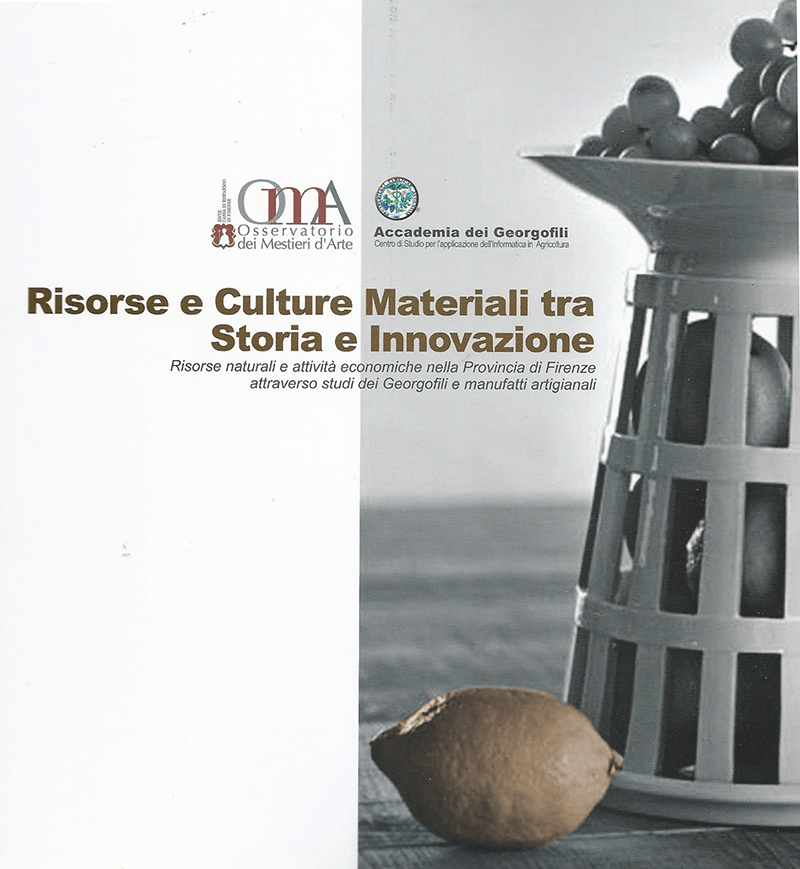
Resources and Material Cultures between History and Innovation
Natural resources and economic activities through the study of Georgophiles and handicrafts
Exibition curated by
Claudio Conese, Bernardo Rapi, Stefano Follesa, Maurizio Romani, Piero Battista, Maria Pilar Lebole.
Table of contents
- Foreword
- Exposition Plan
- Purpose of the exhibition
- Themes and criteria
- The Georgophiles, debates and promotion
- The Observations of Giovanni Targioni Tozzetti
- Economic condition and manufacturing activity between the eighteenth and nineteenth centuries in the writings of Attilio Zuccagni Orlandini
- Geography and History of the places in the Emanuele Repetti Dictionary
- Material cultures on the territories of the province of Florence
- The early twentieth century 1900 – 1950
- The late twentieth century 1950-2000
- A look into the future
- Contributions
- "Popular" pottery, the terracotta and the agricultural evolution of Tuscany between the eighteenth and nineteenth centuries - Franco Berti
- Straw culture in Signa - Roberto Lunardi, Maria Emirena Tozzi Bellini
- Objects and places Stefano Follesa
- List of documents and artefacts present in the exhibition
- Bibliography
The effect of man on the planet as a whole is increasingly evident even outside scientific circles, which for decades have warned of the inconsistency of human activities with the laws of nature that regulate the presence of the biosphere.
The increase in population, the increasingly massive use of fossil energy and the use of increasingly intrusive chemical molecules, are all elements that pose a series of questions regarding the sustainability of this development for a long time.
To this must be added other ethical and political concerns that apply mainly to industrialized countries, such as excess consumption which makes us lose sight of the distinction between the concepts of necessary useful and superfluous, the tendency towards an organization of society that go back to only two categories of the rich and the poor in a pattern similar to that existing before the industrial revolution. In addition, the power of the media that is able to orient the masses erasing any critical capacity, the subjection of political economy with serious consequences for public governance that tends to be interested more and more to the interests of big business and less and less to the needs of citizens, emphasizes the social divide and the malaise of populations.
The globalization that severs ties with the territories to which they belong with the loss of values gained over the course of history and fundamental for a good governance of local communities, the migrations of millions of people who seek an answer to the conditions of misery present in their countries, often with consequences which deprive them of the reference points of the cultures of origin and at the same time make it difficult to integrate on the part of cultures that receive them (often only for the basic manpower needs), the quality and properties of individual work that becomes increasingly anonymous and lacking in deep motivations, with the consequent frustration of large masses of workers driven only to accept it out of necessity, risk accelerating the unsustainability of the current development model.
Faced with such a complex and critical framework without making catastrophism, it is necessary to promote a reflection as soon as possible. Initiatives such as the exhibition "Natural resources and economic activities through the study of Georgophiles and handicrafts" take on the meaning of an invitation to reflect.
The territory tells our story; each tree, field, church, house is the fruit of the work, of the hopes, of the knowledge of the generations that preceded us, are a patient and arduous construction of our identity. In a moment of epochal changes in our civilization, which require careful reflection to face the global challenges of the new millennium, this initiative wants to trace a path that, starting from the past, turns to the future. When entire continents appear at the window of the global economy, calling into question that economic and productive structure that has been painstakingly achieved in the last century, it is necessary to ask what new income job opportunities it is possible to imagine starting from the resources available in the territories.
It is therefore a matter of enhancing our history in a modern key, for this activity that seemed a few years ago to be relegated to the family photo album, must be reconsidered in a new light. The local products represent the symbol of this reflection. Different ways of producing can coexist and enrich each other; on one hand the industrial production that allows everyone access to basic necessities, on the other hand the artisanal one that enhances the resources of the territory, ancient knowledge and modern research, with a view to customizing the product that can to transform us again from consumers of goods often imposed completely from the outside into careful critics who know how to recognize the value of the raw material, of the creative and personal design, of the quality of the creations.
Certainly it must be taken into account that this latter philosophy has a price and that any artisan production for its uniqueness must be understood as a sort of work of art a peculiarity of our civilization and in particular of our region, certainly none of us will never aspire to have a statue of Michelangelo in your home but maybe you can decorate it with a piece of furniture designed for him or wear a suit designed and made just for him, in short, an object of artistic craftsmanship!


